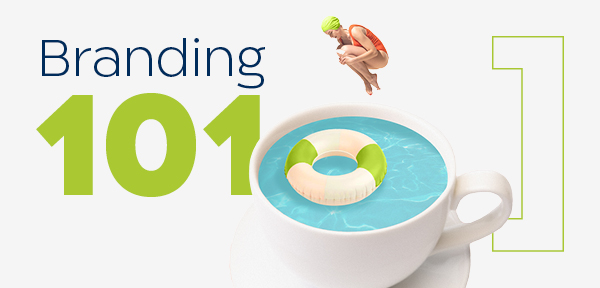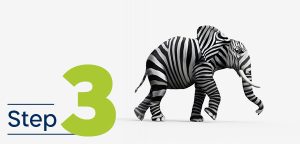September 3, 2023

“What does the branding process involve?” This is a question we often answer for clients and potential clients throughout the year. So, we decided to break it down into three simple steps.
Before we dive into all that, let’s start with the basics – what is branding? Branding is how you distinguish yourself to your audience, communicate who you are, what you stand for, and what you sell. Branding is created by professional designers and brought to life through a name, logo, visual and textual language, and more. However, it’s important to understand that branding is not just a visual differentiator; it’s also about creating an emotional connection with your audience. A company’s branding allows customers not only to identify it in a post, sign, or packaging but also to express emotions and attitudes toward it, sometimes without even knowing the company directly.
Step One – How to Start the Branding Process for a Business?
The start is life itself, because every day we’re exposed to hundreds of messages, ideas, videos, texts, and images. Later it all comes together, and our mind begin processing all these inspirations into new, original, and unique design and language for a specific client.
At Oz, we make sure our team, in this case, our designers, is exposed to diverse content worlds and various content styles. This opens up their minds to creativity, from which different brands for different companies can blossom (even if they’re in the same industry, they’ll create something unique and original – that’s the beauty of it!). The branding process for a business begins as a strategic process where we research and analyze the brand, the product, the company, or the service – and answer the age-old questions – what is the company’s vision, what makes the company special, what customers expect, and what the competition offers. To differentiate the brand effectively, it’s essential to examine competitors – what visual and textual language they use, what messages they convey to the world, and what their customers think of them.
During this examination, we come across tons of content and inspiration on the web, and it’s a fantastic process. All the research and in-depth analysis, combined with the ideas and inspirations, meld together to form the foundation of the brand – the unique value proposition, the narrative, the promise, and the brand’s values.
Step Two – How to Implement the Branding Process?
This is the step everyone seems to be familiar with – the name, logo, fonts, color palette. Supposedly.
Since everyone talks about this step, it’s crucial to understand that without a solid foundation and thorough research, it won’t work. The brand’s cornerstones (based on the strategic messages, remember?) need to be creatively and visually translated into the brand’s language – both in verbal elements (the brand’s name and slogan) and visual elements (the logo, fonts, shapes, and colors).
The brand’s domain, characteristics, and values will be expressed through its visual appearance. Importantly, the design should not only be eye-catching but should also have longevity. Trends come and go, but your branding should remain stable for years.
Our designers have the ability to translate the emotional world into the visual world, making your target audience express positive emotions, identify with your brand, and remember your look (for the next time they encounter you) – or in short, to create an impactful brand for you.
Step Three – How Does a Business Change as a Result of Branding?
So, we’ve gathered inspiration, worked with a professional branding agency (like OZ, ahem), researched, and analyzed, and the designers have prepared sketches.
And the most exciting part – the management approved it! So now what? Implementation!
At the end of the branding process and the creation of the brand’s visual language,
it’s time to infuse it into every marketing and reputation aspect of the company.
The new language will be applied across the board – on social networks, envelopes, outdoor signs and ads, physical offices, pens and notebooks – anything that comes to mind
(and if it doesn’t, our client managers have plenty of ideas).
Effective design is measured by its versatility. If the base has a strong and focused idea, it will be clear how to continue and develop that into the brand’s language in every format – digital and print.















 As a company that leads Israeli B2B companies to success in the global market, we’ve developed a structured five-step process to ensure marketing directly advances the company’s business decisions.
As a company that leads Israeli B2B companies to success in the global market, we’ve developed a structured five-step process to ensure marketing directly advances the company’s business decisions.
 The beauty of this process lies in its clarity. Every marketing effort is measured by its direct contribution to the business. If it’s not in the plan, there’s a reason.
It may sound simple - and it is - but it requires you to pause, plan, and sometimes partner with an external professional. Someone who will hold you accountable, challenge your thinking, and keep you focused. Someone who’s done this many times before and knows how to steer the process.
The cheetah doesn’t wait - and the year won’t either. Now is the time to focus your marketing on what truly matters for your business and drive real impact. We’re here to help.
The beauty of this process lies in its clarity. Every marketing effort is measured by its direct contribution to the business. If it’s not in the plan, there’s a reason.
It may sound simple - and it is - but it requires you to pause, plan, and sometimes partner with an external professional. Someone who will hold you accountable, challenge your thinking, and keep you focused. Someone who’s done this many times before and knows how to steer the process.
The cheetah doesn’t wait - and the year won’t either. Now is the time to focus your marketing on what truly matters for your business and drive real impact. We’re here to help.





